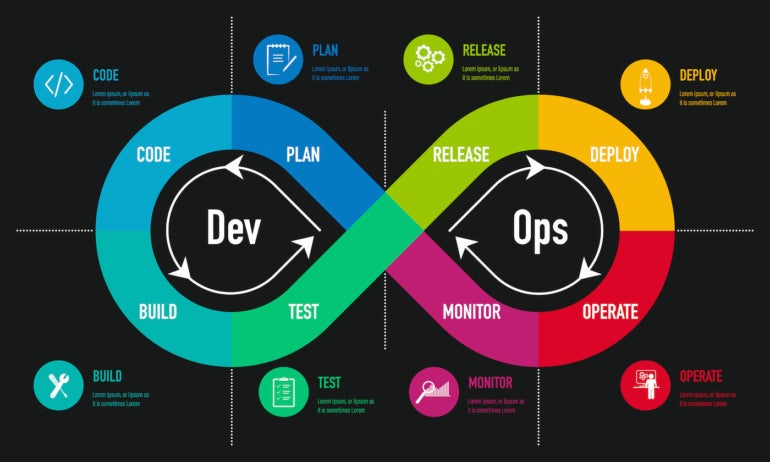
DevOps is a revolutionary methodology that brings together software development and IT operations teams and promotes improved collaboration, efficiency, and continuous delivery. For some, DevOps serves as a set of practices to help them deliver higher-quality software faster. To get the most out of DevOps, however, your software development team should view it as a cultural philosophy.
In this guide, we will discuss the various values or principles that serve as the foundation of the DevOps movement. While these principles can help you understand DevOps better, they can, more importantly, serve as a framework to form your team’s best practices, prevent overwhelm, and lead you to success.
Jump to:
DevOps collaboration
The most basic definition or explanation of DevOps is that it integrates software development (Dev) and IT operations (Ops) teams. In other words, collaboration is critical to DevOps and sits at the methodology’s core. Through collaboration, the development team can optimize the software’s configuration for the operations stages. The operations team, meanwhile, can start testing software earlier to make sure it passes all requirements.
For collaboration to work well, development and operations teams must share information effectively. Any issue found when software is deployed should be logged. This can ensure that the development team fixes the issue in future versions. Through the open communication and collaboration that DevOps promotes, teams can generate a shared sense of ownership and responsibility for the entire software development lifecycle (SDLC).
Information is not the only thing that should be shared between teams for DevOps to function as intended, as feedback is also essential. Positive feedback can motivate teams and remind them of the importance of their work and how essential their roles are to overall success. And negative feedback is essential and even more valuable since it helps teams make continuous improvements to the software they deliver. Feedback should be gathered during all stages of development and deployment via continuous monitoring and performance metrics. And teams should also get customer feedback to improve products and provide satisfaction to end-users.
To help enhance collaboration in DevOps tools, we have a list of some of the Best DevOps Collaboration Tools for Developers.
Make decisions based on data
Making decisions based on data is another DevOps principle. This means using facts and information to influence your choices. When you need to pick the proper technology or DevOps tool to optimize your work process, gather data around each option. Look at how well the tool performed in the past. Does it align with your team’s metrics and goals? If so, it is probably the right choice for your team’s needs, and you can proceed.
For example, a common performance metric for many teams is how long it takes to fix an issue. The longer the issue lingers, the more trouble it can cause. By knowing the average time it takes to fix an issue, you can make data-based decisions when implementing new procedures or tools to your pipeline. Compare the results of the procedure/tool versus your benchmark average, and you can figure out if it will be harmful or beneficial.
Keep customers in mind
While making data-based decisions is a DevOps principle, so is making customer-based decisions, as the methodology stresses delivering value to users. Making decisions and taking actions that benefit the customer, fulfill their needs, and improve satisfaction should be a top priority in DevOps.
When making a decision, a team should question whether or not that choice will help the customer. Getting customer feedback on the current product is essential in optimizing it for the future.
Live monitoring of application performance helps DevOps teams fix issues before they negatively impact customers. Special tools help monitor real-time user interaction to help spot any problem areas. Thanks to the speed and efficiency of the DevOps lifecycle, teams can quickly issue updates to fix those problems and ensure customers enjoy the smoothest experience possible.
We have a great list of Application Performance Monitoring Tools to help you find the right APM software for your team.
DevOps automation
DevOps allows for faster software delivery, patches, updates, etc. When properly practiced, the methodology offers this added speed through automation, as DevOps teams aim to automate as much of the SDLC as they can.
Automation not only accelerates everything, but it also handles tedious, manual tasks. This gives team members more time to write code, research new features, be creative, and complete other essential tasks, and it also increases job satisfaction. Those are not the only benefits DevOps automations provide, though, as it also boosts productivity and reduces human error.
How can project managers and developers automate their infrastructure, testing, deployment, monitoring, and other processes? Through the wide variety of DevOps automation tools, such as Ansible, Jenkins, Bamboo, Chef, GitLab CI/CD, and more.

Example of Ansible Automation Tool
Continuous improvement
Continuous improvement is another DevOps focus and principle. It states that teams should constantly focus on making their products better through upgrades and new features. It also follows the Agile methodology’s use of incremental releases.
In the past, software development teams aimed to release the perfect product right from the start. While that may sound great, the goal of perfect releases resulted in long delays as teams worked to fix issues. With incremental releases, teams shift their goals and aim to deliver the most basic version of the software or minimal viable product (MVP) as quickly as possible.
The MVP has sufficient functionality to meet core customer needs. Once delivered, teams work to perfect the product by gradually adding new, valuable features until the ideal software is finally achieved. By using this incremental method, the customer gets to use and benefit from the product in its essential form without having to wait. They also get accustomed to its new features as they are released and become comfortable with the product over time, versus having to learn it all at once via the old method.
End-to-End responsibility
The development team codes and builds an application in the traditional way of developing software. Once finished, they pass it on to the operations team for testing, deployment, and delivery to the customer. What happens to the bugs found during that second stage? The operations team is responsible for them, versus the development team who actually wrote the code.
DevOps takes a different approach that leans heavier on logic and stresses responsibility throughout the entire product lifecycle. Instead of the development team being responsible for the product in one stage and the operations team having responsibility in another, both teams share responsibility from beginning to end. During the entire lifecycle, DevOps has development and operations teams collaborate to fix issues and release updates.
The developers most familiar with the source code will be tasked with fixing issues and adding improvements and new features. This emphasizes the production of high-quality code, plus finding and fixing bugs as they appear, which results in a better product for the customer.
Embrace failure
DevOps makes software development flexible. As the software being produced improves on a continuous basis, so do the processes used to create it. A key to achieving such flexibility is to encourage risk-taking and embrace failure and view it as an opportunity for learning and improvement.
Risks can result in failure or success. Even if an experiment fails and no success is achieved, it offers a learning experience. It tells you what works and what does not, and this knowledge can be used for data-based decision-making when planning future strategies.
While embracing failure is a DevOps principle, there is a way to fail, gain that desired learning experience, and ensure it does not negatively impact the customer. That way is through early testing, as it lets you spot and fix issues prior to deployment.
Final thoughts on DevOps principles
The DevOps principles listed above can serve as a guiding light to optimize your pipeline. Collaboration is the fundamental principle. Communicate and work closely with your team to implement these principles, and remember to always keep the customer in mind.
SEE: Best Prep Courses for DevOps Certification
Source of Article



